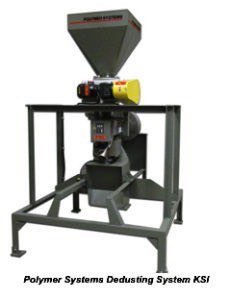Processors Maximize Regrind Use with Efficient & Cost-Effective Dedusting Technology
 A growing number of plastics processors are realizing major manufacturing efficiencies and significant costs savings with the use of customized dedusting systems that eliminate dust, fines, and contamination to maximize the use of plastic regrind. Plastic parts manufacturers, such as blow molders, extruders, and injection molders – place a high value on regrind because it lowers material cost and increases profit margins. However, a big stumbling block in the plastic scrap reclaim process is dust which adversely affects processing, lowers material quality, increases equipment maintenance, causes rejected parts, and raises cost.
A growing number of plastics processors are realizing major manufacturing efficiencies and significant costs savings with the use of customized dedusting systems that eliminate dust, fines, and contamination to maximize the use of plastic regrind. Plastic parts manufacturers, such as blow molders, extruders, and injection molders – place a high value on regrind because it lowers material cost and increases profit margins. However, a big stumbling block in the plastic scrap reclaim process is dust which adversely affects processing, lowers material quality, increases equipment maintenance, causes rejected parts, and raises cost.
Faced with the need to improve efficiencies and reduce cost, one leading U.S. blow molder of high-density polyethylene (HDPE) containers for the food and pharmaceutical industries turned to the latest dedusting technology from Hosokawa Polymer Systems, a leading supplier of recycling systems based in Summit, New Jersey. Previously, the blow molder ran reject parts through a central granulator and the granulate was sent to an outside company for re-pelletizing at an extra cost. The blow molder also experienced machine downtime and quality defects which all resulted in a drag on the bottom line.
The blow molder successfully tested and trialed Hosokawa’s KSI Dedusting System and immediately saw a significant improvement in regrind productivity and output, along with major cost advantages. The company realized a payback in just four months and eliminated the need to re-pelletize its white HDPE regrind. Depending on production levels, Hosokawa estimates that its dedusting systems, which range in capacity from 50 to 10,000 lb/hr, can yield a cost savings of $25,000 to $35,000 per quarter. Moreover, reject rates can fall 80% to 90%, thus reducing granulation and reprocessing overall.
The Hosokawa model KSI slashed labor costs that were incurred in unclogging material lines, blender cleaning (dust), filter changing, and transporting re-pelletized gaylords from warehouse to the blending room and vice versa. Other key advantages were reduced wear and tear on pumps and filters and a significant reduction in machine downtime.

Meanwhile, an extruder of PVC sheet experienced similar favorable results, noting that filter cleaning has been significantly reduced from every two to three hours to once every two weeks. That company has decided to outfit their operation with six more Hosokawa Dedusting Systems over the next several months.
Often used in-line with granulators, the KSI Dedusting System comes with a static elimination system and can be fitted with ferrous/non-ferrous metal separation capability. The unit has a capacity to process 1,000 lb/hr and is easily retrofitted to existing granulator systems. The KSI is easy to maintain, clean, and operate. Changing the system “Cutpoint” or amount of dust removed is simple and quick, taking about five seconds. The unit’s laminar flow design is unique and the most efficient in neutralizing static charge. The KSI handles a range of materials from commodity products to engineering resins like nylon, polycarbonate, and thermoplastic elastomers and is perfect for masterbatch.
The ability to convert scrap plastic into high quality, useable regrind by reducing dust content is vital for processors who want to improve quality and enhance manufacturing performance while at the same time gain bottom line advantages. Customized dedusting technology from Hosokawa is an important tool that delivers these real-time efficiencies that translate into greater profits for the processor.


